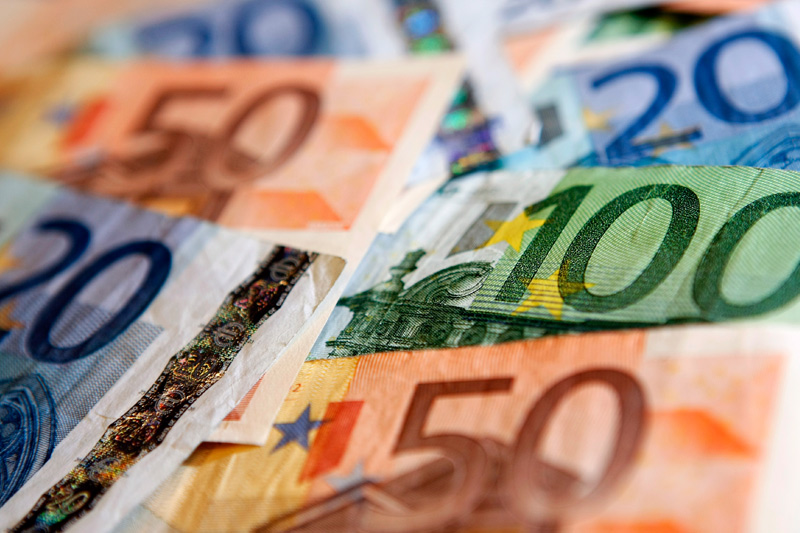Investing.com - The euro was broadly lower against its major counterparts on Thursday, as sustained concerns over the economic and fiscal outlook for the region weighed on demand for the single currency.
During European late morning trade, the euro was lower against the U.S. dollar, with EUR/USD down 0.32% to trade at 1.2666.
The euro weakened broadly after data showed that manufacturing activity in the euro area contracted at the fastest pace since June 2009 this month, with the purchasing managers’ index falling to 44.8, down from a final reading of 45.1 in May.
The euro zone’s services PMI ticked up to 46.8 from 46.7 in May, against expectations for a dip to 46.5, but remained well below the 50 level that separates contraction from expansion.
Manufacturing activity in Germany slowed to the lowest level in three years in June, as the ongoing euro zone crisis hit export demand.
The dismal data came after a report showing that China’s HSBC PMI for June fell to 48.1 compared with 48.4 in May, remaining in contraction territory for the eighth straight month.
Investors remained cautious ahead of the outcome of an audit of Spanish banks later in the day, amid concerns that the results could show that a EUR100 billion bailout for the country’s banks agreed earlier this month would not be large enough.
Spain’s Treasury sold slightly more than the targeted amount of EUR2 billion at an action of government debt earlier in the session, but the country’s borrowing costs rose sharply.
The average yield on the five-year bond climbed to 6.07%, up from 4.96% at a similar auction last month.
Meanwhile, the greenback remained supported after the Federal Reserve announced Wednesday that it is extending the current bond buying program until the end of the year, disappointing expectations for more aggressive measures, following a recent string of weak U.S. data.
The single currency was down against the pound, with EUR/GBP shedding 0.29% to trade at 0.8060.
The pound found support after official data showed that U.K. retail sales rose by a seasonally adjusted 1.4% in May, beating expectations for a 1.2% gain.
The shared currency was marginally higher against the yen, with EUR/JPY easing up 0.18% to trade at 101.24, and was steady against the Swiss franc, with EUR/CHF dipping 0.01% to hit 1.2009.
The euro was broadly lower against the Canadian, Australian and New Zealand dollars, with EUR/CAD slipping 0.09% to hit 1.2926, EUR/AUD dipping 0.08% to hit 1.2456 and EUR/NZD down 0.61% to hit 1.5860.
The New Zealand dollar strengthened after official data showed that the country’s economy grew by 1.1% in the three months to March, beating expectations for a 0.5% rise and following a 0.4% expansion the previous quarter.
Later in the day, European Central Bank head Mario Draghi was to speak.
The U.S. was to produce government data on unemployment claims, followed by preliminary data on manufacturing activity and an industry report on existing home sales. The country was also to release data on manufacturing activity in the Philadelphia area.
During European late morning trade, the euro was lower against the U.S. dollar, with EUR/USD down 0.32% to trade at 1.2666.
The euro weakened broadly after data showed that manufacturing activity in the euro area contracted at the fastest pace since June 2009 this month, with the purchasing managers’ index falling to 44.8, down from a final reading of 45.1 in May.
The euro zone’s services PMI ticked up to 46.8 from 46.7 in May, against expectations for a dip to 46.5, but remained well below the 50 level that separates contraction from expansion.
Manufacturing activity in Germany slowed to the lowest level in three years in June, as the ongoing euro zone crisis hit export demand.
The dismal data came after a report showing that China’s HSBC PMI for June fell to 48.1 compared with 48.4 in May, remaining in contraction territory for the eighth straight month.
Investors remained cautious ahead of the outcome of an audit of Spanish banks later in the day, amid concerns that the results could show that a EUR100 billion bailout for the country’s banks agreed earlier this month would not be large enough.
Spain’s Treasury sold slightly more than the targeted amount of EUR2 billion at an action of government debt earlier in the session, but the country’s borrowing costs rose sharply.
The average yield on the five-year bond climbed to 6.07%, up from 4.96% at a similar auction last month.
Meanwhile, the greenback remained supported after the Federal Reserve announced Wednesday that it is extending the current bond buying program until the end of the year, disappointing expectations for more aggressive measures, following a recent string of weak U.S. data.
The single currency was down against the pound, with EUR/GBP shedding 0.29% to trade at 0.8060.
The pound found support after official data showed that U.K. retail sales rose by a seasonally adjusted 1.4% in May, beating expectations for a 1.2% gain.
The shared currency was marginally higher against the yen, with EUR/JPY easing up 0.18% to trade at 101.24, and was steady against the Swiss franc, with EUR/CHF dipping 0.01% to hit 1.2009.
The euro was broadly lower against the Canadian, Australian and New Zealand dollars, with EUR/CAD slipping 0.09% to hit 1.2926, EUR/AUD dipping 0.08% to hit 1.2456 and EUR/NZD down 0.61% to hit 1.5860.
The New Zealand dollar strengthened after official data showed that the country’s economy grew by 1.1% in the three months to March, beating expectations for a 0.5% rise and following a 0.4% expansion the previous quarter.
Later in the day, European Central Bank head Mario Draghi was to speak.
The U.S. was to produce government data on unemployment claims, followed by preliminary data on manufacturing activity and an industry report on existing home sales. The country was also to release data on manufacturing activity in the Philadelphia area.
